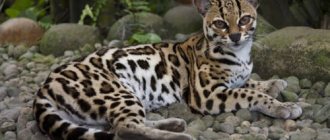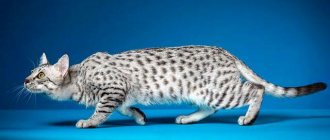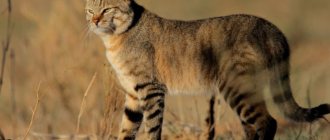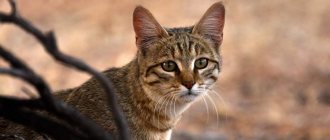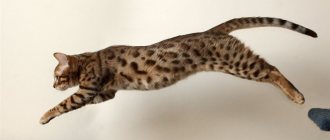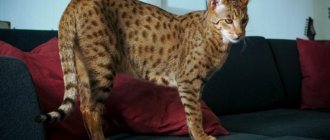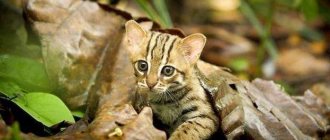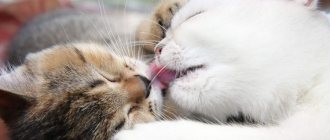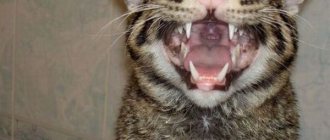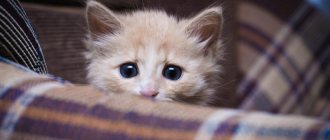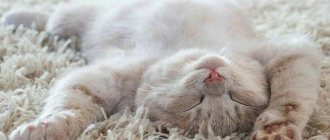Home » Cat Breeds
Wild and domestic cats belong to the same diverse cat family. Among domestic cats there is more external diversity, which man achieved through long selection. For wild cats, their appearance helps them survive and hunt. Among all wild cats, the steppe cat is most similar to a domestic cat.
- 2 Description of the appearance of the steppe cat
- 3 Behavior and habitat
- 4 Life in captivity
Who is the prairie cat?
The steppe cat (Felis Silvestris Lybica) is a wild cat that is a subspecies of the European forest cat. The history of the origin of the subspecies is interesting. 170,000 years ago the subspecies separated from the main species. And 10,000 years ago, these cats were domesticated by the inhabitants of the Middle East - this is evidenced by the images of steppe cats on ancient Egyptian frescoes. They became the progenitors of all modern breeds.
Steppe cats are the ancestors of all domestic purrs
The subspecies Felis Silvestris Lybica belongs to the cat family (Felidae), subfamily of small cats (Felinae), genus of cats (Felis), species of forest cats (Felis Silvestris). Previously, the Lybica group (steppe cats) was divided into two subgroups, each of which had several more representatives:
- subgroup steppe cats (ornata-caudata): Felis silvestris caudata (discovered in 1874);
- Felis silvestris gordoni (1968);
- Felis silvestris iraki (1921);
- Felis silvestris nesterovi (1916);
- Felis silvestris ornata (1832);
- Felis silvestris tristrami (1944).
- Felis silvestris cafra (1822);
However, recently zoologists have decided to simplify the classification. Now all steppe cats are divided into African (Fs lybica), Asian (Fs ornata) and South African (Fs cafra).
Category in the Red Book - 4: Very rare, small in number, poorly studied species, the population dynamics of which are unknown. Due to loss of habitat, poaching and close proximity to people, steppe cats are in danger of extinction.
The steppe cat is a rare species that is in danger of extinction
Description of the appearance of the steppe cat
All three subspecies of steppe cats differ in appearance. Characteristics of the African Steppe Cat:
- Coat color ranges from gray-yellow to brown-sandy or sandy.
- Pattern: tabby mackerel (striped).
- Distinct wide black stripes on the tail and legs. The stripes on the body are reddish or brown, indistinct and barely noticeable.
- The coat is short, with sparse undercoat, soft, and does not fit tightly to the body.
- Body length can be from 45 to 75 cm.
- The tail length varies from 20 to 38 cm.
- Weight - from 3.5 to 6.5 kg.
- The cat's legs are twice as long as the width of the body, thin and slender.
- The cat's head is medium in size, gracefully set on a muscular, rather long neck.
- The ears are large, wide, with rounded tips, set high and straight, slightly tilted forward.
- The eyes are large, almond-shaped, green or yellow.
The African steppe cat (Fs lybica) is distinguished by its long slender legs
Asian steppe cat:
- The color of the coat is sandy, brownish, and may have a grayish or reddish tint. In general the color is lighter and warmer than that of Fs lybica.
- The coat pattern is spotted tabby.
- Small black spots with clear contours are located in random order on the fur. There are distinct stripes on the legs and tail.
- The coat is short, smooth, soft, almost devoid of undercoat, and does not lie very tightly to the body.
- Body length - from 47 to 79 cm.
- Tail length is 30–40 cm.
- Weight - from 3.5 to 7 kg.
- The legs are shorter than those of Fs lybica and more muscular. The frame is also heavier.
- The head is round, small or medium, the neck is short and muscular.
- The ears are small, wide, rounded at the tips and set wide apart.
- Large, almond-shaped eyes can be green, yellow or amber.
The Asian steppe cat (Fs ornata) has a spotted coat pattern
South African steppe cat:
- The color of the coat can be iron-gray with a reddish tint, red-gray with a tint of ocher.
- The coat pattern is mackerel or spotted tabby.
- Dark brown or black stripes cover the legs and tail. Reddish or brownish stripes or spots on the body are pale and almost invisible.
- The coat is thick, short, with a rather thick undercoat, soft, smooth.
- Body length - from 45 to 70 cm.
- Tail length is 25–38 cm.
- Weight - from 3 to 6 kg.
- The legs are strong, muscular, and quite long.
- The head is medium size, rounded, graceful. The neck is short and muscular.
- The ears are large, their height varies from 6 to 7 cm. The tips are rounded.
- The eyes are medium or large and can be light green or light yellow.
The South African prairie cat (Fs cafra), like all prairie cats, has small tufts on its ears.
MANUL
What does the word MANUL
in dictionaries:
- Asian cat
- Asian nocturnal predator
- Asian predator
- Asian wild cat. steppes and deserts
- Wild cat of the Asian steppes and deserts
- Wild cat with valuable fur
- Wild cat in Altai
- Wild cat that looks like a lynx
- Another name for caracal
- From felines
- Ugly ear cat
- Cat on a 500 manat coin
- Desert cat
- Cat with desert registration
- A cat running across the desert
- Cat living in the desert
- The cat who is at home in the desert
- Desert cat
- Cat predator with tassels. on the ears
- Cat predator with tufted ears
- Cat predator with tassels on ears
- Valuable cat fur
- Pallas's cat
- Cat from postage stamps of Azerbaijan and Mongolia
- Large steppe cat
- Who is depicted on the commemorative silver coin of Turkmenistan
- Small predatory cat
- Night cat
- Question: Pallas's cat - answer: Manul
- In another way, it is also called “Pallas’s cat” in honor of the famous Russian scientist
- Desert-Asian relative of the lynx
- Fluffy wild cat
- Symbol of the Moscow Zoo
- Cucumber variety
- Steppe cat caracal
- Predatory cat
- Predator in Altai
- Feline predator
- there is an animal in the photo
Coat that rhymes with "coat"
Behavioral characteristics and habitat
Steppe cats are crepuscular animals. They usually go hunting in the evening. It feeds on small rodents, birds and their eggs, lizards, insects and amphibians. Hunts from ambush, tracking prey and attacking in one leap. Before hunting, it licks itself thoroughly, hiding its scent. As a rule, these cats spend the day hiding in the burrows of porcupines or foxes or hiding in dense bushes.
They have enough enemies in nature: people, hyenas, jackals, dogs, large cats. When meeting an enemy, the steppe cat, if it does not have time to escape, arches its back, turns sideways to the danger, bristles its fur, presses its ears back and hisses, trying to appear larger and more terrible. When attacked, she falls on her back, fights off with her claws and howls furiously.
Steppe cats fight back furiously when attacked
Most of the time, these cats are silent and do not make unnecessary sounds. The range of their “speech” is quite large: snorting, hissing, grumbling, meowing, howling. They become most vocal during the rutting period.
Steppe cats live alone, meeting only during the mating season. However, at the same time, they have rich facial expressions and a wide variety of poses through which they communicate with their relatives.
A female steppe cat most often gives birth to three kittens.
The mating season for steppe cats usually begins at the end of January and lasts until the beginning of March. At this time, the males are unusually active, chasing each other with loud meows and fighting for the female.
Pregnancy lasts 2 months. From 2 to 6 cubs are born, which the female raises alone. Kittens are born blind and deaf, and gain sight and hearing by 9–12 days of age. The female feeds them with milk for up to 2 months, then switches them to meat food. From 3 months, cubs go hunting with their mother. The cubs go “free swimming” at the age of 6–9 months, when the change of teeth from milk to molars ends.
Steppe cats become independent at 6–9 months
Steppe cats become sexually mature by the age of one year, but do not participate in reproduction until the age of 2 years. In captivity they often live up to 8–10 years; in the wild they live much shorter. They settle, as a rule, next to colonies of rodents, and often next to human settlements.
Where can you find the steppe cat:
- In the steppe, desert and sometimes mountainous regions of Africa.
- In Western, Middle and Central Asia.
- In Northern India.
- In Transcaucasia.
- In Kazakhstan.
- The steppe cat is also found on the territory of Russia, in semi-desert areas or floodplain bushes of the Astrakhan region, where it usually stays close to water.
Prairie cats are territorial. The hunting grounds of one animal can range from 2 to 5 km2. Females tend to have a smaller territory.
The habitat of the steppe cat - Africa and Central and South Asia - is declining very quickly
How does a manul live and what does it eat?
Pallas's cat lives in fairly harsh climatic conditions, with low temperatures and sudden changes in weather. The Pallas's cat prefers low snow cover, as its short legs do not allow it to move through deep snow. Therefore, the wild cat Pallas's cat is most numerous in areas with little snow.
Pallas's cat lives in steppes and semi-desert areas of mountains, choosing places with thickets of bushes, the presence of stone deposits and rock cracks. In the mountains, the manul cat rises to 3-4.5 km above sea level. It is rare in lowlands and forest belts.
The Pallas' cat lives sedentary and solitary, usually being active at dusk and early in the morning. During the daytime, he sleeps, hiding in a shelter. The wild manul makes its shelter under stones, in old burrows of marmots, foxes and badgers, as well as in small caves and rock crevices. The Pallas's cat is a territorial predator that jealously guards its territory and does not like guests, so it expels any unwanted visitor.
The color of the Pallas cat serves this wild cat as a kind of camouflage, which helps him in hunting and allows him to remain unnoticed by prey. However, the manul cat is one of the most clumsy and slow representatives of the cat family. But excellent eyesight and hearing allow him to be a skilled catcher.
Pallas's cat feeds on various mouse-like rodents and pikas. Occasionally, Pallas's cat feeds on hares, birds, gophers and marmots. Manul catches its prey by cunning. He waits for her at the hole or watches for the victim, hiding near the stones, after which he attacks, making a sharp lunge. This wild cat is very careful when hunting. Pallas's cat is not able to run fast, so chasing prey is not his strong point. In summer, the Pallas's cat feeds on various large insects, in case of a shortage of rodents.
Despite its harsh appearance, the Pallas's cat is not aggressive. Pallas's cat has practically no enemies; only wolves and large birds of prey pose a danger to this wild cat. The animal Pallas' cat is not one of those who is in a hurry to start a showdown and repel the enemy. This cat is trying to flee and lie down in a shelter. But when the Pallas cat is caught by surprise and there is no escape route to the shelter, then he begins to snort menacingly and bares his sharp teeth.
